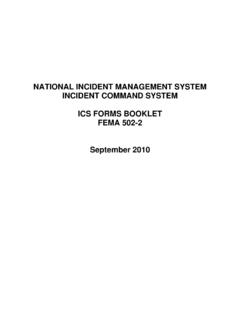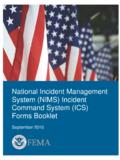Transcription of FEMA Form ICS-213 - Scott ARES
1 fema form ICS-213 Scott County ARES Accurate Rapid communications for our Served Agencies Bob Reid EC March, 2010 Scott County ARES fema ICS213 General Message form 16 Mar10 page 2 Contents Introduction and Background Info 3 form 213 Description 4 Completing the 213 Preamble 6 Text 7 Sample Message 8 Ready to send 9 Listing the traffic 10 Transmitting the message 10 Reply Message 11 Transmitting the reply 14 Final Comments 15 fema form ics 213 16 ITU Phonetic Alphabet 17 Scott County ARES fema ICS213 General Message form 16 Mar10 page 3 The ics 213 General Message form Background The ics 213 General Message form began as a multipart self0copying form for use as an interoffice memo.
2 The layout and use of the 213 form has changed significantly since its inception. The 213 has become the basic written communications document between all areas of emergency response. Users are often located at separate locations and use the 213 form to communicate real time events. Messages originate at one location, are transmitted to another site, and a response may be returned to the originator. The reply message can be combined with the original message for the convenience of the originator. The format of the 213 message form is specified by the served agency. Just as the Incident Command System is adaptable to various incidents, the methods of communications are matched to the situation. The 213 message form may be transmitted by voice, digital, or even hand carried to get the job done. The form 213 can be found at the fema ICS Resource Center website at: The form 213 is specified by the Served Agency.
3 ARES Role The ARES communications volunteer is committed to accurately, rapidly handling information for the benefit of the served agency. ARES operators rely on their equipment, training, and ingenuity in meeting the demands of served agency communications. ARES members must keep abreast of new applications and techniques in emergency communications. ARES role in emergency communications is to move information from point A to point B at the request of the Served Agency. ARES volunteers perform this task using communications procedures developed to provide accurate rapid emergency communications. Scott County ARES fema ICS213 General Message form 16 Mar10 page 4 The 213 form The 213 consists of five areas that are familiar to everyone who has handled NTS format traffic. HEADER TO: line FR: line SUBJECT DATE TIME MESSAGE TEXT SIGNATURE Message originator REPLY 0 Optional SIGNATURE Reply originator Let s take a closer look at each of the message elements.
4 HEADER The information in both the TO: and FROM: lines must contain sufficient information to deliver the message. Obviously this will include the Name, Location, and Title or Position, for each party. An example TO: line would look like this: TO: Ralph Schmitz Shelter East Shelter Manager Likewise the FROM: line would look like this: FROM: Carl Flackscheid EOC Commander The subject line is a concise title for the message that highlights the important point of the message. A SUBJECT might read as follows: SUBJECT: SITREP Request The person originating the message will complete the HEADER information and the MESSAGE TEXT. You may be given verbal instructions to Send a message to X telling them .. You will then fill out the 213 form , get the message okayed by the originator and send the message. Scott County ARES fema ICS213 General Message form 16 Mar10 page 5 MESSAGE TEXT The message text area contains the information to be transmitted.
5 The message should be concise with non0essential words eliminated. Be direct and to the point. Punctuation in the message is indicated with the word X0 Ray. Punctuation, such as commas, parens, question marks are generally not essential to the information and should not be used. Do not end the message text with an X0 Ray. Each word or group of numbers in the text is counted as one word. The sending station can do many things to clarify the words in the text when sending the message. We will look at these techniques when sending a sample message. The message text area is defined during message transmission by the proword BREAK immediately before the first word of the text and immediately following the last word of the text. SIGNATURE This identifies the sender of the message (or reply) and should contain enough information to locate the sender if a reply is received. REPLY The reply message follows the same guidelines as the Message Text.
6 Note: The reply message should reference the message number of the original message. This allows the receiving station to match the reply with the original message. Scott County ARES fema ICS213 General Message form 16 Mar10 page 6 Completing The 213 PREAMBLE The basic 213 form does not contain the pre0printed Radiogram format for the preamble. The trained ARES operator writes the preamble items on the top margin of the 213 form . Sending the 213 form begins with the same preamble used in the NTS format. The preamble contains the following elements: Block #1 - Message Number: This is the serial number assigned by the station that first puts the message into written format. Essentially a message serial number for that station. Block #2 - Precedence: The precedence tells everyone the relative urgency of a message. There are four levels of precedence: Routine, Welfare, Priority, and EMERGENCY.
7 Routine -0 abbreviated with the letter R. Most Amateur traffic is handled using this precedence it is for all traffic that does not meet the requirements for a higher precedence. In a disaster situation, routine messages are seldom sent. Welfare -0 abbreviated as W. Used for an inquiry as to the health and welfare of an individual in a disaster area, or a message from a disaster victim to friends or family. Generally limited to health and welfare inquires on a Red Cross message net. Priority -0 abbreviated as P. For important messages with a time limit; official messages not covered by the EMERGENCY precedence or a notification of death or injury in a disaster area. This precedence is usually associated with official traffic to, from, or related to a disaster area. EMERGENCY -0 there is no abbreviation for the word EMERGENCY is always spelled out. Use this for any message having life or death urgency. The use of this precedence should generally be limited to traffic originated and signed by authorized agency officials.
8 Due to the lack of privacy on radio, EMERGENCY messages should only be sent via Amateur Radio when regular communication facilities are unavailable. If you have ANY doubts about using the EMERGENCY precedence, do not use it. Block #3 - Handling Instructions: This is an optional field used at the discretion of the originating station. The handling instructions contain shorthand instructions for routine message actions. Three of the seven standard HX pro0signs may be used in emergency communications. The three are listed below: HXC 00 Report date and time of delivery (TOD) to originating station. HXD Report to originating station the identity of the station who delivered the message, plus date, time and method of delivery. Also, each station to report identity of station to which relayed, plus date and time. (This traces the message through the network. Seldom used.) HXE 00 Delivering station to get and send reply from addressee.
9 When multiple instructions are used the elements are combined in the Precedence: HXCE. Block #4 - Station of Origin: This is the FCC call sign of the first ham that put the message into written format. Number Precedence HX__ Orig Stn Check Place Time Date #1 #2 #3 #4 #5 #6 #7 #8 Scott County ARES fema ICS213 General Message form 16 Mar10 page 7 Block #5 - The Check: The check is the number of words in the text section only. Include any periods or punctuation (written as X, spoken as X0 Ray ). Words used in determining the CHECK are defined as unique blocks of information and may include numbers, dates, times, etc, in addition to what is usually thought of as words. Block #6 - Place of Origin: This is the location specified by the originator in the TO: line in the 213 form . This information will determine where a reply will be sent, if needed. Block #7 - Time Filed: This is the time as specified in the SUBJECT: line of the 213 form .
10 During emergencies, use local time with indicators such as CST or CDT to eliminate confusion by emergency management personnel. Use 240hour (Military) format. If there is a delay in transmitting the message, insert the time the message is entered into the system in place of the time in the subject line. Block #8 - Date: This is the date the message was created as listed in the SUBJECT: line of the 213 form . Be sure to use the same date as the time zone indicated in Block 7. Use the form of DAY MONTH 23 Jun. The preamble is created by the ARES member and transmitted before the actual 213 form . The information in the preamble is written across the top of the 213 form in the top margin. The preamble information is used to track message receipt and delivery and improve accuracy. Emergency personnel other than amateur radio operators would not necessarily be familiar with the message preamble. The HEADER and the TEXT are separated by the proword BREAK just as in NTS traffic.



